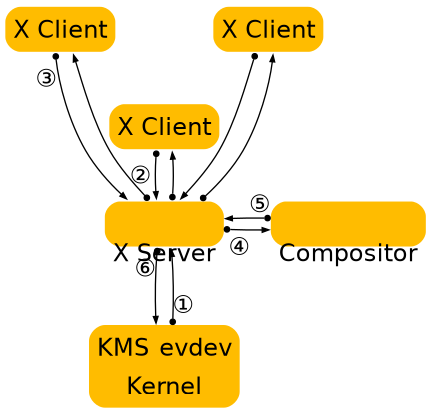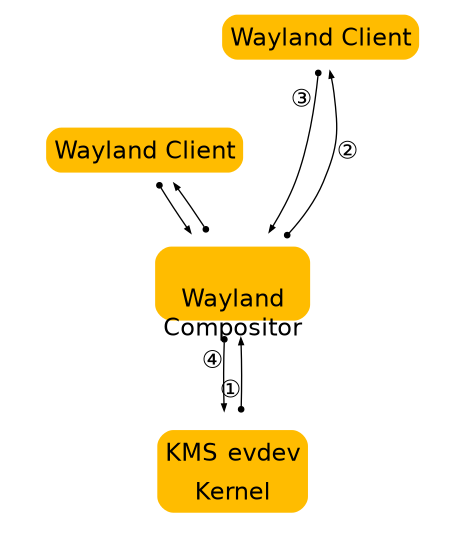Table of Contents
Most Linux and Unix-based systems rely on the X Window System (or simply X) as the low-level protocol for building bitmap graphics interfaces. On these systems, the X stack has grown to encompass functionality arguably belonging in client libraries, helper libraries, or the host operating system kernel. Support for things like PCI resource management, display configuration management, direct rendering, and memory management has been integrated into the X stack, imposing limitations like limited support for standalone applications, duplication in other projects (e.g. the Linux fb layer or the DirectFB project), and high levels of complexity for systems combining multiple elements (for example radeon memory map handling between the fb driver and X driver, or VT switching).
Moreover, X has grown to incorporate modern features like offscreen rendering and scene composition, but subject to the limitations of the X architecture. For example, the X implementation of composition adds additional context switches and makes things like input redirection difficult.

The diagram above illustrates the central role of the X server and compositor in operations, and the steps required to get contents on to the screen.
Over time, X developers came to understand the shortcomings of this approach and worked to split things up. Over the past several years, a lot of functionality has moved out of the X server and into client-side libraries or kernel drivers. One of the first components to move out was font rendering, with freetype and fontconfig providing an alternative to the core X fonts. Direct rendering OpenGL as a graphics driver in a client side library went through some iterations, ending up as DRI2, which abstracted most of the direct rendering buffer management from client code. Then cairo came along and provided a modern 2D rendering library independent of X, and compositing managers took over control of the rendering of the desktop as toolkits like GTK+ and Qt moved away from using X APIs for rendering. Recently, memory and display management have moved to the Linux kernel, further reducing the scope of X and its driver stack. The end result is a highly modular graphics stack.
Wayland is a new display server and compositing protocol, and Weston is the implementation of this protocol which builds on top of all the components above. We are trying to distill out the functionality in the X server that is still used by the modern Linux desktop. This turns out to be not a whole lot. Applications can allocate their own off-screen buffers and render their window contents directly, using hardware accelerated libraries like libGL, or high quality software implementations like those found in Cairo. In the end, what’s needed is a way to present the resulting window surface for display, and a way to receive and arbitrate input among multiple clients. This is what Wayland provides, by piecing together the components already in the eco-system in a slightly different way.
X will always be relevant, in the same way Fortran compilers and VRML browsers are, but it’s time that we think about moving it out of the critical path and provide it as an optional component for legacy applications.
Overall, the philosophy of Wayland is to provide clients with a way to manage windows and how their contents are displayed. Rendering is left to clients, and system wide memory management interfaces are used to pass buffer handles between clients and the compositing manager.

The figure above illustrates how Wayland clients interact with a Wayland server. Note that window management and composition are handled entirely in the server, significantly reducing complexity while marginally improving performance through reduced context switching. The resulting system is easier to build and extend than a similar X system, because often changes need only be made in one place. Or in the case of protocol extensions, two (rather than 3 or 4 in the X case where window management and/or composition handling may also need to be updated).